Padmaprabha
Padmaprabha, also known as Padmaprabhu, was the sixth Jain Tirthankara of the present age (Avsarpini).[1] According to Jain beliefs, he became a siddha - a liberated soul which has destroyed all of its karma.
| Padmaprabha | |
|---|---|
6th Jain Tirthankara | |
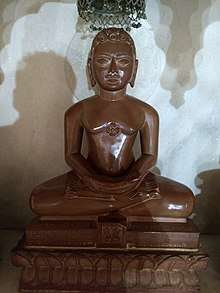 Padmaprabha statue at Anwa | |
| Other names | Padmaprabhu |
| Devanagari | पद्मप्रभ |
| Venerated in | Jainism |
| Predecessor | Sumatinatha |
| Successor | Suparshvanatha |
| Symbol | Lotus |
| Height | 250 bows (750 meters) |
| Age | 3,000,000 purva (211.68 Quintillion years) |
| Color | Red |
| Personal information | |
| Born | |
| Parents |
|
| Part of a series on |
| Jainism |
|---|
 |
|
Jain prayers |
|
Ethics |
|
Major sects |
|
Texts |
|
Festivals
|
|
|
In the Jain tradition, it is believed that Padmaprabha was born to King Shridhar and Queen Susimadevi in the Ikshvaku dynasty at Kausambi[1] which is in today's Uttar Pradesh, India. Padmaprabha means ‘bright as a red lotus’ in Sanskrit.It is said in Śvetāmbara sources that his mother had a fancy for a couch of red lotuses – padma – while he was in her womb.[2]
His birth date was the twelfth day of the Kartik krishna month of the Indian calendar. On the eleventh day of the dark half of the month of Margashirsh, Bhagwan Padmaprabha, along with other 308 saints was liberated and attained moksha on Sammet Shikhar (mountain).
Previous Births
Maharaja Aparajit ruled over Susima town located in Dhatki realm in Purvavideh region in Vatsa country. He was a simple and religious person. He got detached after listening to the discourse of an Arihant and took diksha from Acharya Pihitashrava. As a result of long spiritual practices, he earned Tirthankar-nama-gotra-karma. Completing his age, he reincarnated as a god in the Graiveyak realm.
Biography as per Jain traditions
From the realm of gods, the being that was Aparajit descended into the womb of queen Susima, wife of the king of Kaushambi. One day, queen Susima had a desire to sleep on a bed made up of lotus flowers. As this was a desire of a pregnant mother, the gods made arrangements for its fulfillment. On Krishna Dwadashi (twelfth day of the waning fortnight) of the month of Kartik, the queen gave birth to a son. The new born had a soft pink glow like lotus flowers. The king named him as "Padmaprabha" (meaning one with lotus-like glow).
In due course, the prince became young and was married. When his father left for spiritual practices, Padmaprabh ascended the throne. After a long and successful reign, when through his threefold knowledge he knew that the right moment has come, he became an ascetic. After six months of spiritual practices, on the full moon day of the month of Chaitra he attained omniscience under a banyan tree. Propagating right religion for a long time, Bhagavan Padmaprabh wandered around and at last arrived at Sammetshikhar. He attained Nirvana on the eleventh day of the dark half of the month of Margshirsh.
Association
Padmaprabha is associated with Red Lotus emblem, Chatrabha tree,[3] Manovega (Dig.) & Mangupta (Svet.) Yaksha and Syama Achyuta (Svet.) Yakshi.[4]
Famous Temple
Gallery
 Padmaprabhu Tonk, Shikharji
Padmaprabhu Tonk, Shikharji Footprint at Padmaprabhu Tonk, Shikharji
Footprint at Padmaprabhu Tonk, Shikharji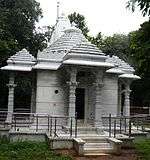 Padmaprabha Temple, Madhuban
Padmaprabha Temple, Madhuban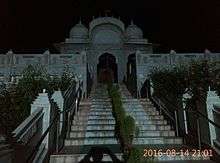 Padampura
Padampura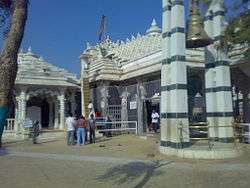 Padmaprabhu Jain Temple at Mahudi
Padmaprabhu Jain Temple at Mahudi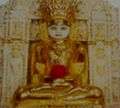 idol at Padmaprabhu Jain Temple at Mahudi
idol at Padmaprabhu Jain Temple at Mahudi Padmaprabha Tirthankar at Chennai Museum
Padmaprabha Tirthankar at Chennai Museum
See also
| Wikimedia Commons has media related to Padmaprabha. |
Notes
References
- Johnson, Helen M. (1931), Padmaprabhacaritra (Book 3.4 of the Trishashti Shalaka Purusha Caritra), Baroda Oriental Institute
- Krishna, Nanditha; Amirthalingam (2014) [2013], Sacred Plants of India, Penguin Books, ISBN 978-9-351-18691-5
- Tandon, Om Prakash (2002) [1968], Jaina Shrines in India (1 ed.), New Delhi: Publications Division, Ministry of Information and Broadcasting, Government of India, ISBN 81-230-1013-3
- Tukol, T. K. (1980), Compendium of Jainism, Dharwad: University of Karnataka